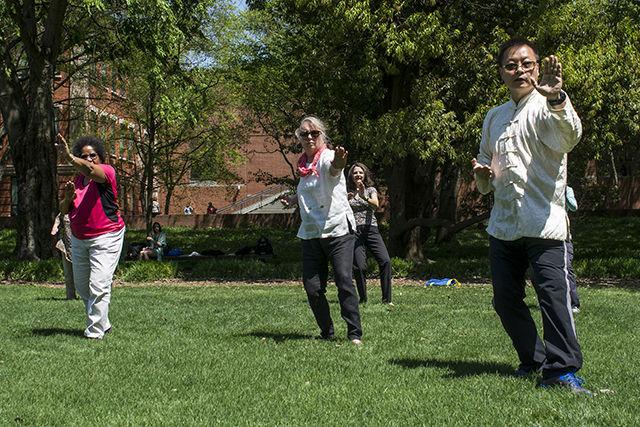Tai chi is like water. Through gentle, fluid motions, one redirects their opponent’s attacks and moves defensively. When striking back, tai chi, like water, can turn from being gentle to being powerful and strong in reaction.
Xiaozhong Tang, an associate professor of English from Nanjing Normal University and member of NC State’s Confucius Institute, has been teaching a tai chi group for eight weeks with a session every Tuesday. He meets with the participants on the grassy field near Caldwell Hall and leads the class through the various poses and movements.
Tang started teaching tai chi three years ago and teaches twenty-four forms in the Yang style that he believes are the most popular in China. Out of the two forms of tai chi, Yang style is younger than Chen style and is more easily accepted because it is not that fierce, according to Tang.
Tai chi is a martial art first and an exercise second, and mindfulness of one’s breathing is one of the key practices to learn, according to Tang.
“Usually tai chi—when you just observe it—it’s not like a martial art, but definitely and generally, it’s a martial art,” he said. “For the average person, if they don’t have any martial art skills, what they’re going to try to do is learn the basic skills that will be a little bit related to the martial art, such as the breathing.”
Usually stances will have the knees bent so that the individual has more stability and cannot be easily pushed by their opponent, and it is one of the harder things for the participants to do constantly, according to Tang. Because of this, he asks the participants to go back and forth between bent and straight legs.
“The second thing about tai chi is the softness,” Tang said. “The softness is just from trying to be gentle and paying more attention to your breaths.”
As the program continued, more and more staff members became interested in learning and joined, according to Tang.
“The basic thing I want to talk about for martial arts including tai chi – I just want to emphasize the softness and harmoniousness,” he said. “If you punch me or kick me or fight against me, I just want to move back and gently defend it instead of fiercely fighting against you.”
The fluidity of the movements is related to the nature of redirecting the opponent, but tai chi can be used to react and attack as well.
“When I find I cannot go anywhere, I have to fight against you. I just use a softness to carry off your fierce power and get ready for fighting against you,” Tang said.
The practice of tai chi is also based on a certain state of mind and care for other people and the environmental surroundings.
“Chinese culture really emphasizes kindness, just like the water,” Tang said. “We’re paying attention to the water flowing because it simulates gentleness. Also, water can have another side. If you don’t pay attention to your environment, you’re going to be damaged by the water. That means we have to respect each other, just like tai chi. You push me, and I just avoid, but if you still push me, then I will have to push you in retroverse,”
Members of this group said that teachings of tai chi have had effects that extend beyond physical benefits for participants.
“Going step by step and learning the different reasons for doing different steps, also practicing the breathe in, breathe out through each step of that has been very calming for me,” said Kevin Swann, an NC State staff member with the Confucius Institute. “It’s like a moving meditation. I’m kind of utilizing it for a meditation in motion.”
Tang said that the idea of kindness and gentleness serves as a basis for tai chi.
“First, kindness is prior to analysis,” he said. “Second, kindness is like the water. A person, their personality and their behavior must be like the water. Human beings cannot live independently of water, so that means we need water. We have to be like water, so that means people will need you.”








